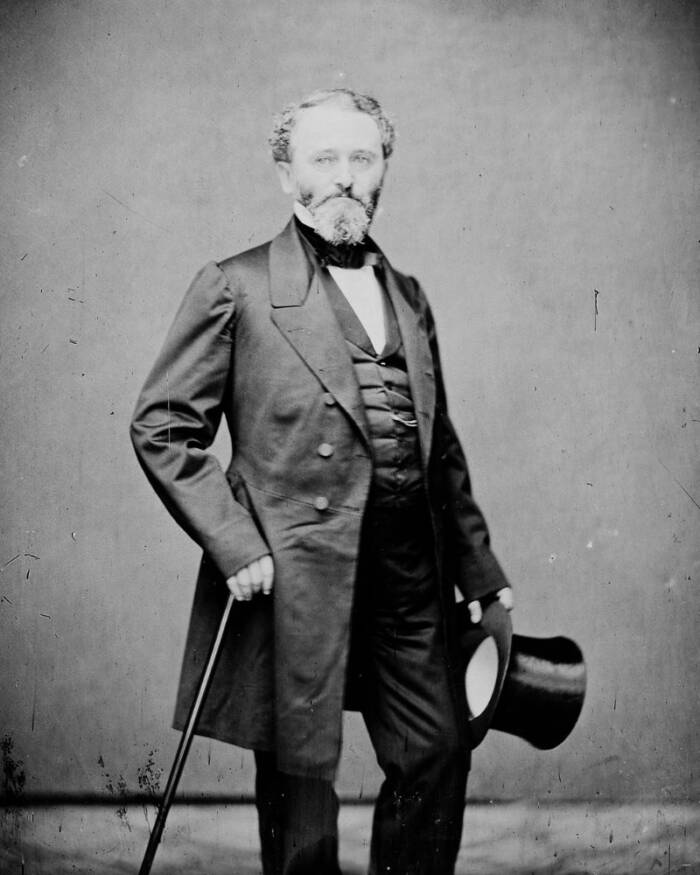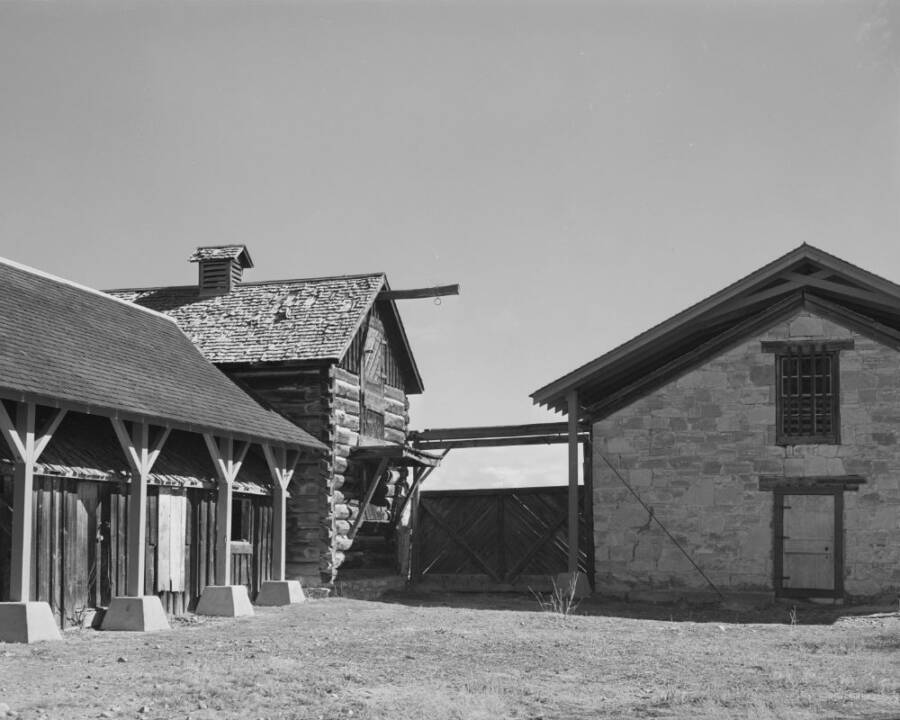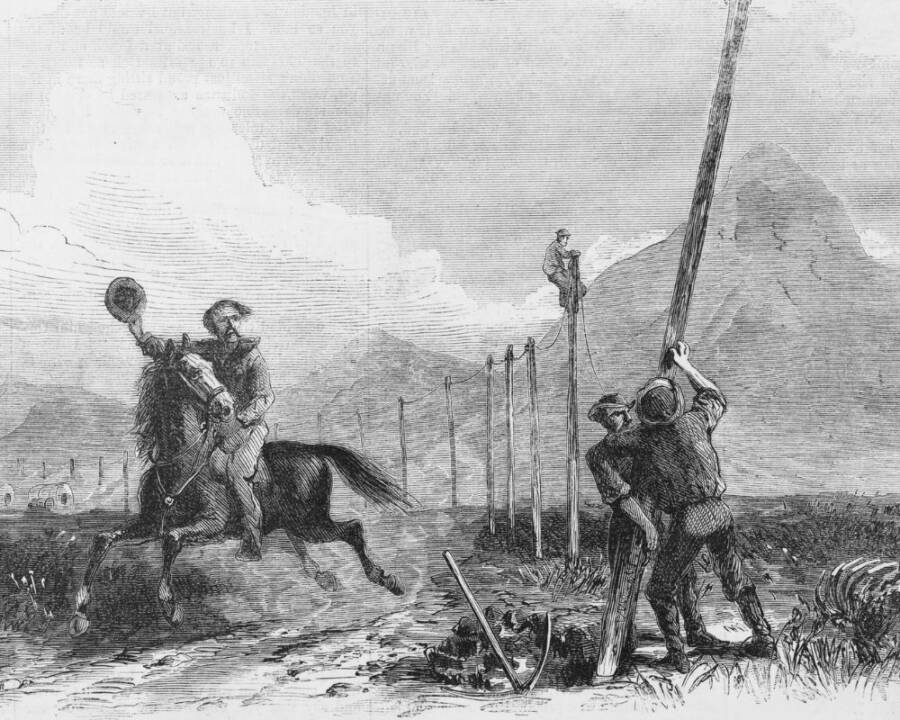Though the Pony Express is synonymous with the Old West today, it was only in service from April 1860 to October 1861.
The Pony Express is one of the hallmarks of the Wild West, but the mail delivery service was actually only around for 18 months, from April 1860 to October 1861.
Created to deliver news and correspondence from the East Coast to the West Coast, the Pony Express consisted of 400 horses, 80 riders, and nearly 200 relay stations scattered every 10 to 15 miles across the American Frontier. Mail that previously took 24 days at best to travel across the country now arrived in just 10.

Wikimedia CommonsAn 1860 poster advertising the Pony Express mail delivery service.
But the service had its drawbacks, too. It was costly — and dangerous. So when a telegraph line was completed connecting Missouri and California in October 1861, the Pony Express shut down for good.
Though ultimately short-lived, this horse-powered mail delivery service nevertheless remains an iconic part of America’s past.
The Origins Of The Pony Express
In 1848, a carpenter named James Wilson Marshall came across flecks of gold while building a sawmill for his employer, John Sutter, near Coloma, California. The discovery sparked the California Gold Rush, which saw some 300,000 hopeful prospectors race to the territory to seek their fortunes.
Two years later, California officially became part of the United States. Meanwhile, travelers on the Oregon Trail were settling in surrounding western territories, and Mormon pioneers had made a home for themselves in Salt Lake City. The population of the American West was booming — but there was still no easy way to communicate with the East Coast.

Wikimedia CommonsBy the 1860s, San Francisco was already a bustling city, but receiving news from the East Coast could take weeks.
Railroads from major eastern cities only stretched as far as the Mississippi River. The fastest way for mail or news to travel between the coasts was by ship. The Pacific Mail Steamship Company carried letters from New York to Panama, where either a train or horseback riders transported the correspondence across the isthmus. There, a second ship would take the mail from Panama to San Francisco.
This long journey lasted three weeks in the best of times — but it often took much longer. In fact, people living in Los Angeles in 1850 didn’t learn about California statehood until six weeks after the state had entered the Union.
With the population of the West continuing to balloon, government officials knew they needed to find a way to deliver mail across the country more quickly. In 1857, the Overland Mail Company formed and advertised 24-day delivery via stagecoach. But this still wasn’t fast enough.

Wikimedia CommonsWilliam H. Russell, one of the men who founded the Pony Express.
In late 1859, California Senator William M. Gwin met William Russell, a stage express company owner. The two men discussed creating a 2,000-mile route over which riders would race to deliver mail from St. Joseph, Missouri, to Sacramento, California. In theory, they would travel more than twice as fast as the Overland Mail Company.
Russell and his two partners, William Waddell and Alexander Majors, jumped at the opportunity — and the Pony Express was born.
Creating The Pony Express Trail
While the idea behind the Pony Express was simple, its execution was not. Alexander Majors was tasked with building nearly 200 stations in desolate areas across the country, hiring stock keepers, purchasing more than 400 horses, and enlisting about 80 men to carry the letters.
He had just two months to make it happen.
Majors and his associates first laid out the logistics of the Pony Express Trail: Riders would travel as fast as they could, switching out horses at the stations placed every 10 to 15 miles along the route. Every 75 to 100 miles, a new rider would take over.

Library of CongressPony Express stables in Fort Bridger, Wyoming.
Because weight was such an important factor in timely mail delivery, the men wanted their employees to be young – sometimes under the age of 18 — and small, between 100 and 125 pounds. That’s about the size of a modern jockey.
According to the National Park Service, Russell, Waddell, and Majors posted an ad in the Sacramento Union on March 19, 1860 in search of riders. It read:
Men Wanted
The undersigned wishes to hire ten or a dozen men, familiar with the management of horses, as hostlers, or riders on the Overland Express Route via Salt Lake City. Wages $50 per month and found.
Each man who signed on also had to sign an oath promising not to swear, drink liquor, or fight with their fellow employees. That said, one man named Richard Burton later quipped that he “scarcely ever saw a sober rider.”
Just over two months and $70,000 later, the Pony Express was up and running. The first rider left from St. Joseph on April 3, 1860, carrying 49 letters and five telegraphs. The letters arrived in San Francisco to much fanfare just 10 days later.
The Dangers Faced By Pony Express Riders
Much of the Pony Express Trail followed the route already established by the Overland Mail Company, but it was ultimately 800 miles shorter. Known as the “Central Route,” the trail crossed the plains of Kansas and Nebraska, passed through the Rocky Mountains and into the Great Salt Lake Valley, and wound across the deserts of Nevada and over the Sierra Nevada mountains before ending in the Sacramento Valley.

Wikimedia CommonsA Pony Express rider circa 1861.
The terrain was dangerous, and freezing temperatures, blinding blizzards, and pitch-black nights made the job of a Pony Express rider perilous. Indeed, the first death came just two weeks after the service launched. On April 18, 1860, a horse stumbled on a dark road, crushing its rider.
Riders also frequently encountered indigenous people who had good reason not to trust anyone crossing their lands. In May 1860, the Pyramid Lake War broke out between white settlers and the Paiute Tribe. Paiute warriors began to attack Pony Express stations, killing as many as 16 stock keepers.
Several routes had to close, majorly delaying mail service. And when the trail eventually reopened, the U.S. military had to escort riders until the threat had passed.

Library of CongressAn 1860 lithograph of a Native American warrior pursuing a Pony Express rider.
One brave employee, Henry Avis, laughed in the face of these dangers. According to the National Park Service, Avis took the routes other men were scared to travel. He once traveled 220 miles in a single ride because his replacement refused to cross the territory of a particularly aggressive tribe. He survived and received a $300 bonus for his dedication.
Overall, six riders died during the tenure of the Pony Express. That number surely would have grown — but after just 18 months, the mail delivery service came to a sudden end.
The Rise Of The Telegraph And The End Of The Iconic Mail Service
On Oct. 26, 1861, a telegraph line opened connecting Missouri to the West Coast, allowing for faster and cheaper communication across the United States.
It had initially cost five dollars to send one letter via the Pony Express — the equivalent of $130 today. The cost later dropped to one dollar per half-ounce, but that was still expensive for regular mail. For that reason, the service was mainly used for government correspondence and news delivery. Telegrams could fill that need much more efficiently.
What’s more, because of the manpower — and associated costs — needed to deliver mail from Missouri to California in just 10 days, the Pony Express never turned a profit. In fact, it had lost $200,000 by the time it closed in 1861.

Library of CongressAn illustration from an 1867 edition of Harper’s Weekly depicting a Pony Express rider galloping by men stringing a telegraph wire.
Still, the service had fulfilled its duty for the short period of time it was needed. When Abraham Lincoln was elected president in November 1860, the news had traveled from Fort Kearney in Nebraska to Placerville, California, in a record five days.
Some West Coast residents even missed the Pony Express once it was gone. They complained that the telegraph service was less reliable, as lines often broke, delaying messages.
While the legendary mail service lasted only 18 months, it made an impact on America. Its riders traveled half a million miles across the Old West. They delivered 35,000 pieces of mail. And those who were present when the first 49 Pony Express letters arrived in Sacramento on April 14, 1860 never forgot that thrilling moment in history.
As The New York Times reported upon the occasion: “The city was illuminated, the citizens paraded the streets with bands of music, fireworks were set off, speeches were made appropriate to the occasion, and the best feeling was manifested by everybody.”
After reading about the rise and fall of the Pony Express, discover the forgotten stories of the Wild West’s Black cowboys. Or, enjoy these rare and evocative images of Wild West saloons.





